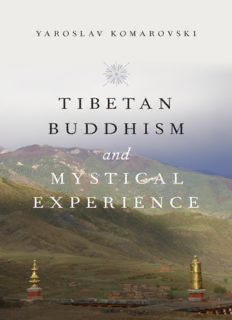
Tibetan Buddhism and mystical experience PDF
Preview Tibetan Buddhism and mystical experience
TIBETAN BUDDHISM AND MYSTICAL EXPERIENCE TIBETAN BUDDHISM AND MYSTICAL EXPERIENCE Yaroslav Komarovski 1 1 Oxford University Press is a department of the University of Oxford. It furthers the University’s objective of excellence in research, scholarship, and education by publishing worldwide. Oxford New York Auckland Cape Town Dar es Salaam Hong Kong Karachi Kuala Lumpur Madrid Melbourne Mexico City Nairobi New Delhi Shanghai Taipei Toronto With offices in Argentina Austria Brazil Chile Czech Republic France Greece Guatemala Hungary Italy Japan Poland Portugal Singapore South Korea Switzerland Thailand Turkey Ukraine Vietnam Oxford is a registered trademark of Oxford University Press in the UK and certain other countries. Published in the United States of America by Oxford University Press 198 Madison Avenue, New York, NY 10016 © Oxford University Press 2015 All rights reserved. No part of this publication may be reproduced, stored in a retrieval system, or transmitted, in any form or by any means, without the prior permission in writing of Oxford University Press, or as expressly permitted by law, by license, or under terms agreed with the appropriate reproduction rights organization. Inquiries concerning reproduction outside the scope of the above should be sent to the Rights Department, Oxford University Press, at the address above. You must not circulate this work in any other form and you must impose this same condition on any acquirer. Cataloging-in-Publication Data is on file at the Library of Congress. ISBN 978–0–19–024495–8 (hbk.); 978–0–19–024490–3 (pbk.) 1 3 5 7 9 8 6 4 2 Printed in the United States of America on acid-free paper I prostrate to the mother of victors of the three times, The unutterable, inconceivable, ineffable perfection of wisdom, The unborn and unceasing space[-like] nature, The object of functioning of individually self-cognizing primordial mind! From Rahulabhadra’s Praise to the Perfection of Wisdom (Prajñāpāramitāstotra) CONTENTS Acknowledgments ix 1. The Mystical Panorama 1 Setting the stage 1 What does Tibetan Buddhism have to do with mysticism and experience? 10 Glancing at the issue of (un)mediated mystical experience 26 2. The Mind Dimension 44 Mind models 46 Conceptuality and direct perception 56 The problem with pure consciousness 68 3. The Path Dimension 79 Path models 79 Mediations: whither and when 93 Negations and deconstructions 102 Contents 4. Mystical Complexities 117 A few words about ineffability 117 Mystical experiences and polemics 127 Mystical commonalities 143 5. Contesting the Ultimate Experience 161 The Geluk position 166 The Sakya position 194 Contemplating differences differently 218 Conclusion and Final Remarks 241 Bibliography 249 Index 263 viii ACKNOWLEDGMENTS Although the idea of writing this book was born less than four years ago, my interest in the topics explored herein was initi- ated by people and events encountered much earlier. I’ve had a vague interest in things “mystical”/mysterious since about age seven. While going to bed I asked my father questions about whether the universe is finite or infinite, what lies beyond it, what lies beyond that which lies beyond it, etc., until I eventually fell asleep. Shortly afterwards, I was discussing with my family such “semi-Buddhist” questions about findability of phenomena as when a car stops being a car: does it happen after one or all of its wheels have been removed, after its doors have been taken away, after its steering wheel has been taken off, earlier, later, when exactly? Although my parents had neither answers to such questions nor interest in philosophical or religious matters, they were understanding, patient, and supportive during my preado- lescent deconstructionist “quest.” In my teens I remember lying
Description: